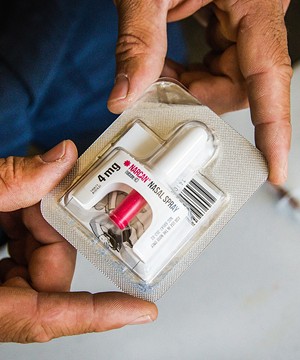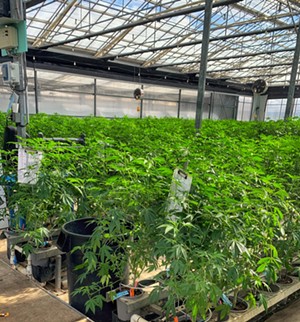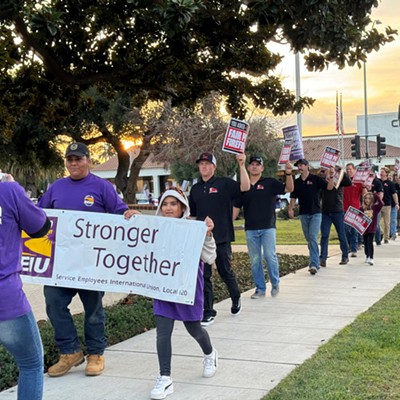As we gaze back at what 2022 brought with it, the big issues that stick out include homelessness, opioid overdoses, and rural crime—all of which were exacerbated in the wake of the pandemic and are still waiting for solutions from public officials. As we head into 2023, expect those conversations to stay on the agendas at public meetings as well as continuing discussions about the cannabis industry and the future of downtown Santa Maria. You can refresh your memory about these things and more by checking out our year-in-review.
Although COVID-19 is still infecting people, it’s not the news story it was in 2020 and 2021: The virus isn’t as virulent as it once was, people are vaxxed and boosted, and hospitals know how to mobilize. Instead, in 2022, Santa Barbara County dealt with increases in opioid deaths, rural crimes, and homelessness. The county’s legacy oil industry faces an uncertain future while the Board of Supervisors made moves to improve things for the cannabis industry, and Santa Maria heads down a path that could finally revitalize its downtown. Read about that and more as the year comes to a close and we head into 2023.
—Camillia Lanham

Record-breaking opioid deaths
In 2021, Santa Barbara County experienced a record-breaking 133 opioid-related deaths, nearly doubling since 2017. Fentanyl—a lethal opiate 50 times more potent than heroin—was cited as the leading cause of that increase. The Santa Barbara County Sheriff’s Office launched Project Opioid to get naloxone—a medication that reverses the effects of an opioid overdose—at more locations across the county and bring together behavioral health leaders, school teachers, administrators, and elected officials to collaborate, find solutions, and reduce stigma. At the state level, the California Legislature passed AB 1598 to remove drug testing strips from the paraphernalia category, allowing for their distribution and use to test substances for fentanyl and ketamine. Project Opioid still has no direct source of funding and no full-time staff dedicated to the project. The county was on track to beat its overdose death record in 2022.
—Taylor O’Connor

Rural crime and trail equity
Farmers and trail advocates debated at county Board of Supervisors meetings about outdoor access for Santa Maria residents and the impacts of rural crime. Students and youth from the Central Coast Alliance United for a Stable Economy (CAUSE) advocated for a 6.7-mile Santa Maria River Levee Trail expansion to add more trail options to Santa Maria—which only has 8 miles of trails and two options as opposed to Santa Barbara’s 130 miles and 53 options. Farmers and agricultural workers protested the expansion due to concerns about an increase in thefts and other incidents on rural properties. Since 2020, rural crime has increased by more than 60 percent and the total property losses are worth more than $2 million. From January to July 2022, the Sheriff’s Office reported 143 crime incidents with losses of more than $500,000. With few law enforcement officers available to respond to these incidents, farmers believed the expansion would lead to even more incidents.
—Taylor

ExxonMobil pulls out
The Santa Barbara County Board of Supervisors voted 3-2 along North/South County lines to deny an ExxonMobil trucking proposal that would have allowed the company to truck crude oil along Highways 101 and 166 from its Las Flores Canyon processing facility to the Santa Maria Pump Station or to the Plains Pentland Terminal in Kern County. It would have also allowed the company to resume operations at three idle platforms that have been shut down since the 2015 Refugio oil spill. In May, ExxonMobil sued the county, claiming that the supervisors’ decision violated the company’s U.S. constitutional rights, specifically the fifth and 14th amendments ensuring the rights to private property and its use. As the lawsuit moved forward, a federal judge ruled in November that conservation and indigenous groups could help legally defend the county in the suit. At the same time, Exxon began the process of selling its offshore units to Sable Offshore Corporation for $643 million in an effort to restart oil operations.
—Taylor

Cannabis county
Santa Barbara County holds 30 percent of all cannabis licenses in California, but processing—which adds value to cannabis products—is limited in the county. The Board of Supervisors voted to change its cannabis rules to make it easier for processing facilities to apply for a permit in hopes of having more processing facilities and generating higher revenues. The city of Guadalupe approved three cannabis projects—two dispensaries and one processing facility—to generate more general fund dollars as the city tries to get out of a major economic deficit. Lompoc continues to be a cannabis industry leader in the county. Its City Council passed a smoking ordinance that would allow for temporary cannabis smoking during large permitted events in public parks. Santa Maria, on the other hand, proposed an ordinance that would restrict both public marijuana and tobacco use. The proposed ban covers outdoor service and dining areas, public event areas, and any other outdoor spaces.
—Taylor
Santa Maria’s headed for change
In Etta Waterfield’s last year as a Santa Maria City Council member, the city continued to debate capping mobile home park owners’ ability to increase rents, gave the green light to start the planning process on redevelopment downtown, and decided against providing live translation services at City Council, commission, and committee meetings. After flooding City Council meetings with public comment, mobile homeowners managed to convince the city to agendize a discussion about stabilizing the rent they pay to park their mobile homes in mobile home parks. Activists also retained an attorney to work with the city on making adjustments to Santa Maria’s existing enforceable model lease—a lease agreement that park owners aren’t required to use that caps the yearly rent increase on mobile home park spaces at 6 percent. In July, the Planning Commission OK’d The Vernon Group’s plans to transform the empty 72,000 square-foot building formerly occupied by Fallas Discount Store into a three-story housing complex with about 100 new units. In August, the City Council approved a development agreement with the same developer to construct a five-story mixed-use building on a city-owned parcel at the southeast corner of Main Street and Broadway. Both projects are part of a larger vision to revitalize downtown Santa Maria into a more pedestrian friendly, vibrant city center. In November Maribel Aguilera-Hernandez was elected to replace Waterfield on the City Council. Incumbent City Councilmember Gloria Soto managed to hold onto her seat by just 38 votes in a tight race against challenger Steven Funkhouser, whose campaign sent out a series of dirty mailers depicting Soto in altered photographs.
—Camillia Lanham

Addressing the homelessness crisis
When Santa Barbara County received state funding to open a new Project Homekey site—a program that renovates hotels and motels into permanent housing facilities for the homeless—the Board of Supervisors proposed the Motel 6 on East Main Street in Santa Maria. City officials rejected the proposal, citing concerns for the project’s success after previous affordable housing projects resulted in eviction issues, criminal activity, and neighborhood disturbances. The county lost the funding, but 5th District Supervisor Steve Lavagnino and 4th District Supervisor Bob Nelson looked for a new space and landed on a county-owned vacant lot for a temporary housing development. The proposed 90-unit facility will be designed by Dignity Moves and modeled after its Santa Barbara location. Although it’s in its early stages, city and county officials seem to be optimistic about the proposal, and it’s expected to go through a public comment period in January. The county also joined the state’s new CalAIM program, which helps qualified organizations get Medical-Cal reimbursement for medical and mental health care and housing navigation services they provide to homeless individuals.
—Taylor













